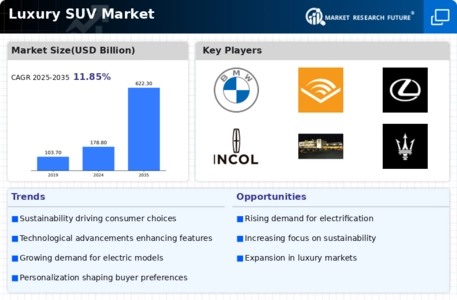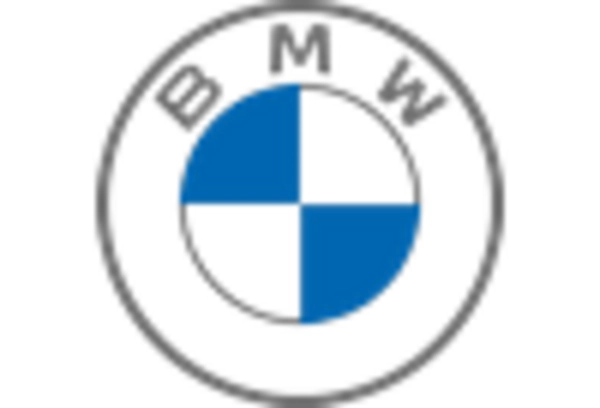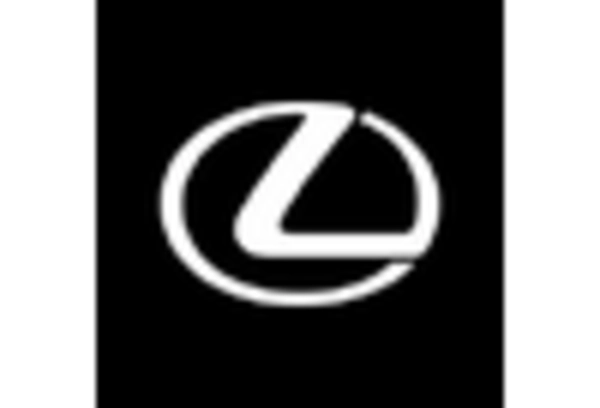Expanding Global Markets
The Luxury SUV Market is benefiting from the expansion of markets across various regions. As urbanization continues to rise, particularly in developing countries, there is a growing demand for luxury vehicles. This trend is evident in regions where economic growth is fostering a new class of affluent consumers. Market data suggests that luxury SUV sales are increasing in Asia and the Middle East, where consumers are eager to invest in high-end vehicles that reflect their status. Additionally, the proliferation of luxury dealerships in these regions is making it easier for consumers to access premium brands. This expansion not only boosts sales but also encourages competition among manufacturers, leading to a wider array of options for consumers. As the Luxury SUV Market continues to grow, the focus on these emerging markets will likely shape the strategies of automakers aiming to capture new clientele.
Rising Disposable Incomes
The Luxury SUV Market is experiencing a notable increase in demand, driven by rising disposable incomes among consumers. As economic conditions improve, more individuals are willing to invest in high-end vehicles that offer both comfort and status. In many regions, the average household income has seen a steady rise, which correlates with an uptick in luxury vehicle purchases. This trend is particularly evident in emerging markets, where a burgeoning middle class is eager to embrace luxury brands. The Luxury SUV Market benefits from this demographic shift, as consumers prioritize quality and prestige in their vehicle choices. Furthermore, the increasing availability of financing options makes luxury SUVs more accessible, further fueling market growth. As a result, manufacturers are likely to expand their offerings to cater to this affluent consumer base.
Technological Advancements
Technological advancements play a pivotal role in shaping the Luxury SUV Market. Innovations in automotive technology, such as advanced driver-assistance systems, connectivity features, and electric powertrains, are becoming increasingly prevalent. Consumers are drawn to vehicles that offer cutting-edge technology, enhancing both safety and driving experience. For instance, the integration of artificial intelligence and machine learning in vehicle systems allows for personalized driving experiences, which is a key selling point in the luxury segment. Additionally, the shift towards electric and hybrid models is gaining momentum, as consumers become more environmentally conscious. This technological evolution not only attracts tech-savvy buyers but also aligns with the broader trend of sustainability within the Luxury SUV Market. As manufacturers invest in research and development, the competition intensifies, leading to a more dynamic and innovative market landscape.
Changing Consumer Preferences
The Luxury SUV Market is witnessing a shift in consumer preferences, with buyers increasingly favoring SUVs over traditional sedans. This trend is influenced by a variety of factors, including the desire for versatility, space, and a commanding driving position. Consumers are seeking vehicles that can accommodate their active lifestyles, making SUVs an attractive option. Additionally, the perception of SUVs as safer vehicles contributes to their growing popularity. Market data indicates that luxury SUV sales have outpaced those of luxury sedans in recent years, reflecting this changing preference. As a result, automakers are responding by expanding their luxury SUV portfolios, introducing new models that cater to diverse consumer needs. This shift not only impacts sales figures but also influences marketing strategies within the Luxury SUV Market, as brands aim to resonate with the evolving tastes of their clientele.
Increased Focus on Sustainability
Sustainability has emerged as a critical driver within the Luxury SUV Market, as consumers become more environmentally conscious. The demand for eco-friendly vehicles is prompting manufacturers to invest in sustainable practices and technologies. This includes the development of electric and hybrid luxury SUVs, which appeal to consumers seeking to reduce their carbon footprint without compromising on luxury. Market trends indicate that a significant portion of luxury vehicle buyers prioritize sustainability in their purchasing decisions. Consequently, automakers are increasingly highlighting their commitment to sustainability in marketing campaigns, showcasing eco-friendly materials and production processes. This focus on sustainability not only enhances brand image but also aligns with the broader societal shift towards environmental responsibility. As the Luxury SUV Market evolves, the integration of sustainable practices is likely to become a defining characteristic of successful brands.


















Leave a Comment